Ivory
RSP 10668
Grower: CSU
General Information
- Sample Name
- Ivory 5
- Accession Date
- February 14, 2017
- Reported Plant Sex
- Female
- Report Type
- StrainSEEK v2 3.2Mb
- DNA Extracted From
- Leaf
The strain rarity visualization shows how distant the strain is from the other cultivars in the Kannapedia database. The y-axis represents genetic distance, getting farther as you go up. The width of the visualization at any position along the y-axis shows how many strains there are in the database at that genetic distance. So, a common strain will have a more bottom-heavy shape, while uncommon and rare cultivars will have a visualization that is generally shifted towards the top.
Chemical Information
Cannabinoid and terpenoid information provided by the grower.
Cannabinoids
No information provided.
Terpenoids
No information provided.
Genetic Information
- Plant Type
- Type III
File Downloads
The bell curve in the heterozygosity visualization shows the distribution of heterozygosity levels for cannabis cultivars in the Kannapedia database. The green line shows where this particular strain fits within the distribution. Heterozygosity is associated with heterosis (aka hybrid vigor) but also leads to the production of more variable offspring. When plants have two genetically different parents, heterozygosity levels will be higher than if it has been inbred or backcrossed repeatedly.
The ratio of reads mapped to Y-contigs to reads mapped to the whole Cannabis genome (Y-ratios) has been demonstrated to be strongly correlated with plant sex typing. This plot shows the distribution of Y-ratios for all samples in our database which were sequenced with the same method (panel or WGS) as this sample and where this sample falls in the distribution.
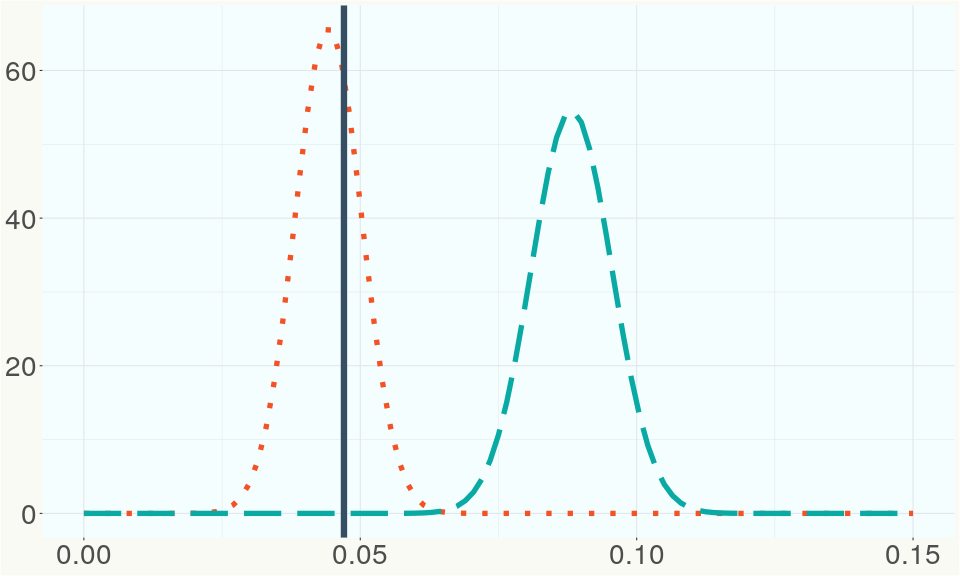
This chart represents the Illumina sequence coverage over the Bt/Bd allele. These are the three regions in the cannabis genome that impact THCA, CBDA, CBGA production. Coverage over the Active CBDAS gene is highly correlated with Type II and Type III plants as described by Etienne de Meijer. Coverage over the THCA gene is highly correlated with Type I and Type II plants but is anti-correlated with Type III plants. Type I plants require coverage over the inactive CBDA loci and no coverage over the Active CBDA gene. Lack of coverage over the Active CBDA and Active THCA allele are presumed to be Type IV plants (CBGA dominant). While deletions of entire THCAS and CBDAS genes are the most common Bt:Bd alleles observed, it is possible to have plants with these genes where functional expression of the enzyme is disrupted by deactivating point mutations (Kojoma et al. 2006).
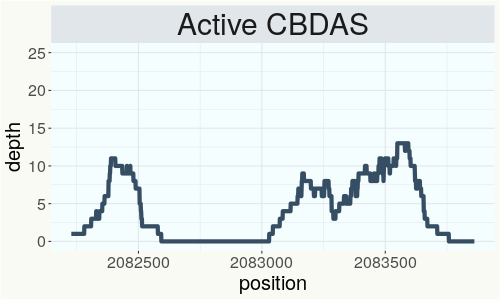
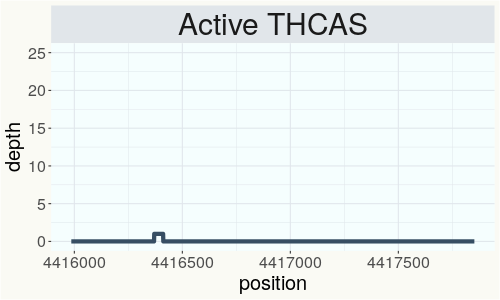
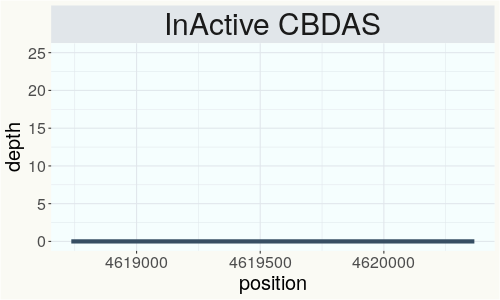
This chart represents the Illumina sequence coverage over the CBCA synthase gene.
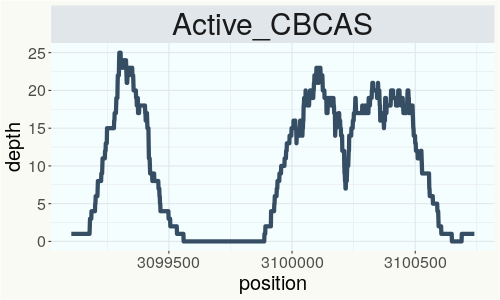
Variants (THCAS, CBDAS, and CBCAS)
No variants to report
Variants (Select Genes of Interest)
| aPT1 |
c.95_97delGT |
p.Cys32del | disruptive inframe deletion | moderate | contig121 | 2835800 | ATGT/A | |
| aPT1 | c.406A>G | p.Ile136Val | missense variant | moderate | contig121 | 2839605 | A/G | |
| HDS-2 | c.679G>C | p.Gly227Arg | missense variant | moderate | contig95 | 1990632 | G/C |
|
Nearest genetic relatives (All Samples)
- 0.181 USO 31 (RSP10983)
- 0.183 Lovrin (RSP10658)
- 0.193 Futura 75 (RSP10664)
- 0.195 Carmagnola USO 31 (RSP11204)
- 0.196 Santhica27 (RSP11046)
- 0.196 Santhica27 (RSP11047)
- 0.198 Fedora 17 (RSP10661)
- 0.199 Bialobrzeskie (SRR14708244)
- 0.199 USO 31 (RSP10981)
- 0.201 R1in136 (SRR14708227)
- 0.203 Tygra (RSP10667)
- 0.206 Santhica27 (RSP10056)
- 0.206 Diana (RSP10235)
- 0.206 Santhica 27 (SRR14708211)
- 0.208 Tisza (RSP10659)
- 0.210 Carmagnola (RSP10982)
- 0.210 Delta-llosa (SRR14708272)
- 0.211 C-930 lot 211005 (RSP12603)
- 0.212 Santhica 27 (RSP10665)
- 0.215 Beniko (SRR14708275)
Most genetically distant strains (All Samples)
- 0.442 Cherry Blossom (RSP11300)
- 0.431 Cherry Blossom (RSP11312)
- 0.423 New York City Deisel (RSP11225)
- 0.422 Up Royale (RSP11257)
- 0.421 Chem 91 (RSP11185)
- 0.421 Cherry Blossom (RSP11309)
- 0.420 Cherry Blossom (RSP11331)
- 0.418 JL Cross 11 (RSP11512)
- 0.416 Super Sour Diesel (RSP11191)
- 0.414 Cherry Blossom (RSP11328)
- 0.413 Cherry Blossom (RSP11319)
- 0.408 JL Cross 10 (RSP11511)
- 0.408 UP Wendigo (RSP11261)
- 0.407 RKM-2018-002 (RSP11093)
- 0.406 Banana OG (RSP11498)
- 0.406 Cherry Blossom (RSP11318)
- 0.405 Escape Velocity (RSP11165)
- 0.405 JL Cross 13 (RSP11514)
- 0.404 Dog Patch (RSP11725)
- 0.404 Cherry Blossom (RSP11316)
Nearest genetic relative in Phylos dataset
- Overlapping SNPs:
- 89
- Concordance:
- 81
Nearest genetic relative in Lynch dataset
- Overlapping SNPs:
- 14
- Concordance:
- 9
Blockchain Registration Information
- Transaction ID
-
8932650d4825bbc8
24b1e1f99da60b6b 0bda796fb8148b4f 844f4b6056efeae2 - Stamping Certificate
- Download PDF (855.9 KB)
- SHASUM Hash
-
10098bffde1cc2df2b025bd3f7a99a78 06614d2402d9cf75 041705985cecac7a